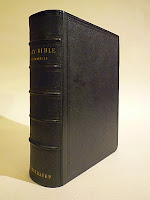Just for a change from Bible restorations, I've started working on a first edition of
Columbus and Columbia by
Historical Publishing Company. (1892) It's a burgundy quarter binding with corners which needs re-hinging. It's got a set of pretty endpapers that the client wants to keep, so I've gotta put in internal hinges to connect the torn papers. I started this job yesterday, so it's almost done. - it's now waiting to be cased in. The original spine's torn in half in the middle, but it's not missing any pieces. So I expect that the end product to be nice looking. Well, just for the sake of mentioning the
quarter binding here, you may want to know what it is and what
ratios of quarter binding styles there are. Quarter bindings are the books with different materials used to make the case, meaning simply, books bound in other than full cloth or leather. Humm.. let see, the first of all, as you might have guessed, there's a
one-quarter binding. The proportion of the spine material to the board material is about 1 to 3. There's also a
half binding. The proportion of the spine material and the board material is 1 to 1, OR, the spine + corner material to the board material is about 1 to 1. And finally, the
three-quarter binding. The proportion of the spine and corner material to the board material is about 3 to 1. It's just a traditional design of bookbinding, so you can do whatever you please if you are binding books, but if you wanna stick to the tradition, measure the ratio, eh? Oh, by the way, there's one particular style I personally like. It's not as common as those just mentioned, but there are books that's got a set of super tiny corners. (The material used for those tiny corner are not only leather but often vellum. Ummm pretty.) I suppose it's more common in older European books, as books in German, ... I love them. In bookbinding trade, everything seems to be there for just design, but they are actually there for specific and practical reasons. The reason why a stronger material (leather) is used on the spine and corners, is because the hinge and corners are the first parts to get damaged. Besides, it's more economical than binding in full leather. For another example, the headbands, either they are sewn or not, they are there to prevent dust from getting into the folded pages. As for the raised bands on the spine, they were basically the actual cords used in sewing of the book, though, it's become so accustomed to be just for a purpose of design after different sewing methods were invented. Bookbinding is sort of like "
form follows function". (Oh, by the way, I majored in Industrial Design in college, yearrrrrrrrs ago. )
// For the completed work of this volume, go to my latter post:
Columbus & Columbia complete 
 About
70% of my work here is to restore older leather bound books, as my master tends
to work on less labor intensive ones. (!! Is he using me!?! Yo, Master! You
aren't retired yet, dude!) So, this is the first cloth bound book I’ve featured
here since starting this blog. I'm not saying all the cloth bound books aren't
complicated, in fact, they are often more complicated to restore than others if
all the original pieces need to be preserved and invisibly repaired. But this
particular book isn't one of them. It's Ching Li and the Dragons by Alice
Woodbury Howard, published by Macmillan Co., (1931).
My job is to create a brand new case with the original front graphic
inlaid onto the front cover and repair torn pages. The client wants the insignia
on the front endsheet to be preserved, so I have to lift it up and put it back
to the original position on the new endsheet. Looks like it was a gift from her
grandma when she was a child. Children's books are like cookbooks and Bibles, -
people want to keep them in their family tradition by bequeathing them to the
next generation. But, boy, the pages of this book! Someone has torn the hell
out of them! (No, it's not her dog, though we often get clients saying "My dog
ate my book!". Seriously... Bad Dog!!)
About
70% of my work here is to restore older leather bound books, as my master tends
to work on less labor intensive ones. (!! Is he using me!?! Yo, Master! You
aren't retired yet, dude!) So, this is the first cloth bound book I’ve featured
here since starting this blog. I'm not saying all the cloth bound books aren't
complicated, in fact, they are often more complicated to restore than others if
all the original pieces need to be preserved and invisibly repaired. But this
particular book isn't one of them. It's Ching Li and the Dragons by Alice
Woodbury Howard, published by Macmillan Co., (1931).
My job is to create a brand new case with the original front graphic
inlaid onto the front cover and repair torn pages. The client wants the insignia
on the front endsheet to be preserved, so I have to lift it up and put it back
to the original position on the new endsheet. Looks like it was a gift from her
grandma when she was a child. Children's books are like cookbooks and Bibles, -
people want to keep them in their family tradition by bequeathing them to the
next generation. But, boy, the pages of this book! Someone has torn the hell
out of them! (No, it's not her dog, though we often get clients saying "My dog
ate my book!". Seriously... Bad Dog!!)
















































